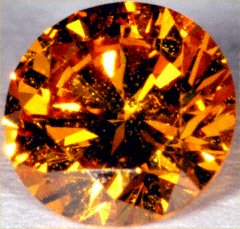| The Very Highest Quality Diamond Information... |
| Synthetic Diamonds |

|
|
|
Synthetic = Real
Many people think the word synthetic means fake, "not real", man made or "not natural". Strangely enough there are some of its dictionary definitions, but the word synthesis actually means put together or assembled. Green plants, for example synthesize chlorophyll. The chlorophyll they produce is genuine, real, natural. and not man made. So in its most pure sense, the word synthetic means put together. assembled, or created. It does not mean unreal.
Synthetic Diamonds Are Real Diamonds
It follows from the above that synthetic diamonds are real diamonds. They are made from carbon, exactly the same as natural diamonds. Currently it is possible to distinguish natural from synthetic diamonds, mainly as a result of different types of inclusions, but at some time in the future it may be possible to create undetectable synthetic diamonds.
Synthetic Versus Simulant
A diamond simulant, sometimes misleadingly called a simulated diamond is not the real thing. A simulant is an imitation. Examples of diamond simulants include glass, sometimes called paste, white sapphire, white spinel, YAG (Yttrium Aluminium Garnet), moissanite, and cubic zirconia.
More Synthetic Diamonds
Sumitomo of Japan are known to have produced gem quality synthetic diamonds since the 1980's if not before, and near colourless gem size and quality diamonds were being produced in Russia before the turn of the millennium, but in the past few years, there have been several media outbreaks of stories about vast possible commercial mass-production of gem quality synthetic diamonds in the USA.
Gemesis
The Gemesis Corporation of Sarasota Florida and New York uses machines developed from Russian technology, but improved and developed by Gemesis itself, producing diamonds under high pressures and temperatures from carbon, dissolved in molten metal, which is allowed to crystallise onto tiny "seed" diamonds. Gemesis market their diamonds, most of which are fancy yellow, as Gemesis Cultured Diamonds.
The pressures used can exceed 400 tons per square inch, and the temperatures 1,600° Celsius.
Back in 2003, America's JVC (Jewelers Vigilance Committee) commented that the FTC (Federal Trade Commission) stated the word "cultured" was not sufficient used by itself to identify the diamond as laboratory created, although it was perfectly acceptable when used to refer to cultured pearls. We believe, as do Gemesis, that this is inconsistent, and that cultured should be allowed as a perfectly acceptable description. The FTC were not concerned about the use of the word "synthetic" because consumers did not understand the word, and wrongly thought it meant imitation.
Apollo
Apollo Diamond Inc., of Boston, Massachusetts also produce synthetic diamonds, including gem size and quality, but by a completely different process. Their process is almost the opposite of the HPHT methods, and is known as CVD, Chemical Vapour Deposition, but in the case of diamond it clould also be called Carbon Vapour Deposition. This technique, which has been in use since before the 1990's, allows carbon vapour to solidify onto a seed crystal in a vacuum. In the past, the technique has been used to build up thin, flat crystals, similar to natural macles, but it has been developed to be able to produce larger and thicker crystals. Apollo moved into commercial production around the end of 2003, and we keep seeing various progress announcements, but they do not appear to be marketing their gem quality diamonds as actively as Gemesis.
Apollo also produce optical devices and semiconductors, and their gem diamond business has grown from these technologies.
All CVD grown diamonds are believed to be type 2a diamonds.
More Producers
It can only be a matter of time before a growing number of commercial producers announce production methods and facilities. We understand that there are numerous patents covering both current production methods, but further techniques may be discovered, and variation of existing techniques may circumvent existing patents. It will be interesting to wait and watch for further developments in the synthetic diamond industry.
Created Diamonds For Sale
A short stocklist of created (synthetic) diamonds for sale.
| ...at the Lowest Possible Price |
|
32 - 36 Harrowside, Blackpool, Lancashire, FY4 1RJ, England. Telephone (44) - (0) 1253 - 343081 ; Fax 408058; E-mail: The URL for our main page is: https://24carat.co.uk | Chard(1964) Ltd |